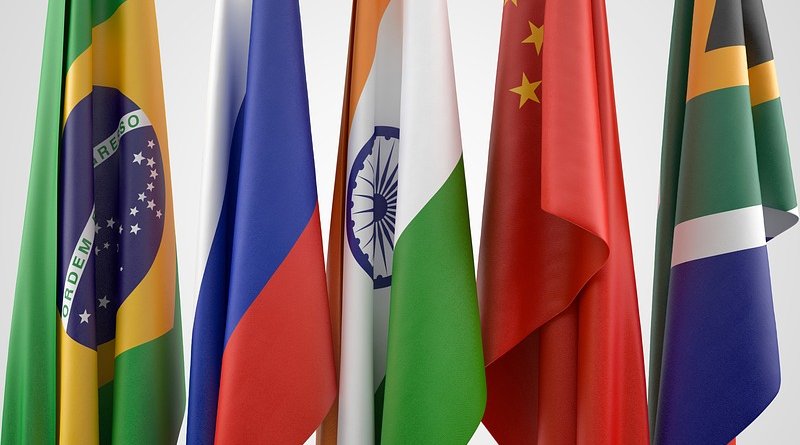Contradictions Grow Amid Another BRICS Summit – Analysis
By Observer Research Foundation
India’s aim in engaging with BRICS may be an effort to demonstrate that it retains strategic autonomy and that it engages with all major powers irrespective of incongruences.
By Rajeswari Pillai Rajagopalan
BRICS, the Brazil-Russia-India-China-South Africa grouping, met virtually on 17 November for its 12th summit meeting. Prior to the meeting, the Indian Ministry of External Affairs (MEA) released a statement saying that the meeting would discuss intra-BRICS cooperation around counterterrorism, energy, trade, health, and ways to mitigate the effects of the COVID-19 pandemic. Each of the five leaders stressed various aspects of cooperation in the face of the pandemic and the resultant economic slowdown.
Chinese President Xi Jinping talked about “global epidemiological security” and said that “the BRICS countries firmly believe in the primacy of international law” and considered the World Health Organisation to be the leading institution in addressing the pandemic. He added that once the pandemic is taken care of, focus must shift to economic recovery. Here, he argued “China can once again lead the way.” Citing how China’s “economy already bounced back from its low point earlier this year,” he said, “its new development paradigm of dual circulation where domestic and international circulation mutually reinforce one another will help stimulate the global economy” as well as “repair the damage done by some countries’ protectionist policies.” He concluded by saying that there will be “hiccups along the way” but “the trust-based relations between the BRICS countries could serve as a very stabilising factor during this unprecedented transition in global political and economic affairs as the world begins to embrace new models.”
Xi’s statements on the primacy of international law and trust-based relations within BRICS are bound to be taken with more than a little skepticism given China’s punitive economic actions against many of its neighbours and even partners further away. Such statements from China are not new. At the BRICS Foreign Ministers meeting last week, Wang Yi, China’s foreign minister, said that the BRICS countries should come together in addressing the challenges of the pandemic and global economic recovery, and foster multilateralism and seek “political settlement of hot-spot issues.”
Indian Prime Minister Narendra Modi also spoke about the impact of the COVID-19 pandemic and the reform process that has been initiated by his government to get the economy back on track. Modi highlighted the need for reform of multilateral institutions such as the IMF, WHO and WTO, but his particular emphasis was on terrorism, which he characterised as “the biggest problem today.” Modi said that the group must ensure that “countries that support and help terrorists are also held to account.”
It is doubtful that the other members of BRICS necessarily share India’s view of the terrorism problem, but that is not the sole difficulty. The BRICS summit is also taking place at a time when India and China have squared off at their border, a temporary line called the Line of Actual Control (LAC). BRICS, as a multilateral platform, cannot address bilateral issues and hence, it was, understandably, not expected to address that particular issue. And given that the summit was held virtually, the possibility of informal bilateral meeting on the sidelines of the summit was nonexistent.
The group itself has always been diverse in terms of economic, political, and security interests. These have only grown over the last two decades as Abhijnan Rej highlighted recently. China has emerged as the world’s second largest economy, while Brazil, Russia, and South Africa are nowhere near the indicators that brought them into the grouping initially.
Politically, too, the group is diverse, with few common political interests other than singing the song of multilateralism. Even that rhetoric may not hold for long given the yawning gap between China’s rhetoric of multilateralism and its unilateral aggressive behaviour on the ground.
China and Russia have an anti-American political goal for the grouping, which sits very uneasily with Indian interests, considering India has invested significantly in building and nurturing its bilateral ties with the United States as well as engaging in strategic minilaterals such as the Quad and various trilaterals in the Indo-Pacific.
That India works with China in the BRICS format, when the aim of India’s Quad and other such minilaterals are to restrict and restrain China’s aggressive and bullying behaviour, adds to the growing array of contradictions. Certainly, BRICS cannot be a military and security grouping given the significant differences between each of the players, most notably between India, China, and Russia. The success of groupings such as BRICS will depend on the health of bilateral ties among those within the group. India-China relations in the backdrop of the Galwan conflict do not suggest that all is well on the bilateral front or even in the regional context.
India’s aim in engaging with BRICS may be an effort to demonstrate that it retains strategic autonomy and that it engages with all major powers irrespective of these incongruences. In this respect, it may serve a limited domestic political agenda. But as contradictions keep piling up, questions about the future of BRICS as anything other than an ineffective talkshop are bound to grow.
This article originally appeared in The Diplomat.

